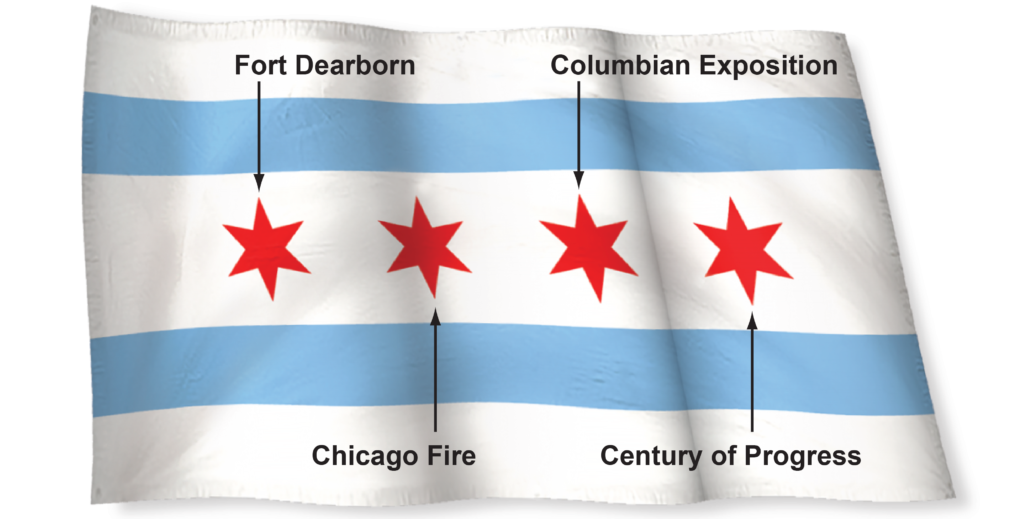Introduction
The Chicago flag is more than a piece of fabric—it’s a banner of pride, a symbol of resilience, and an iconic design that reflects the city’s rich history. Its simple yet profound design, with two blue stripes, four red stars, and a white field, is instantly recognizable to locals and admired by visitors. Whether it’s waving on city buildings, stitched onto jackets, or tattooed on proud Chicagoans, the flag captures the essence of the Windy City.
Let’s take a closer look at the origins, symbolism, and cultural significance of the Chicago flag and why it remains one of the most celebrated city flags in the world.
A Flag Designed to Unite a City
The Chicago flag was born in 1917, a result of a citywide contest aimed at creating a unifying emblem. The winning design came from Wallace Rice, a historian and writer who poured Chicago’s history and spirit into every detail.
Rice didn’t clutter the flag with unnecessary elements or text. Instead, he chose a clean, meaningful design that spoke volumes. His creation resonated then and still does today, over a century later.
Breaking Down the Design
The genius of the Chicago flag lies in its simplicity. Every stripe, every star, and every point on those stars tells a story about the city’s past, present, and values.
The Blue Stripes: Chicago’s Lifeblood
The two horizontal blue stripes represent the city’s waterways—Lake Michigan, the Chicago River, and the Great Canal. These bodies of water have been vital to Chicago’s development as a transportation hub and a center for trade.
The top stripe symbolizes Lake Michigan and the North Branch of the Chicago River, while the bottom stripe reflects the South Branch and the Great Canal. They aren’t just lines—they’re lifelines.
The White Field: A City of Neighborhoods
The white field is divided into three horizontal sections, symbolizing the city’s three main areas:
- North Side
- West Side
- South Side
Each section represents the unique character and culture of Chicago’s neighborhoods, reminding us that while the city is vast, it thrives on its sense of community.
The Red Stars: Chicago’s Defining Moments
The four red, six-pointed stars are the heart of the Chicago flag, each representing a pivotal event in the city’s history:
- Fort Dearborn (1831)
The first star commemorates Fort Dearborn, which played a crucial role in Chicago’s early development. - The Great Chicago Fire (1871)
The second star symbolizes the Great Fire that devastated the city but also sparked its remarkable rebirth as a hub of innovation and architecture. - The World’s Columbian Exposition (1893)
The third star celebrates the 1893 World’s Fair, which showcased Chicago’s cultural and technological achievements to the world. - The Century of Progress Exposition (1933–1934)
The fourth star marks the Century of Progress Exposition, a celebration of the city’s resilience and advancements during the Great Depression.
Each star has six points, which represent key civic values like transportation, labor, and education.
A Flag That Connects Past and Present
The Chicago flag is more than a history lesson. It’s a living, breathing symbol of the city’s resilience and diversity. From sports games to political rallies, the flag is a unifying force that brings Chicagoans together.
Cultural Significance of the Chicago Flag
Woven Into Daily Life
Walk around Chicago, and you’ll see the flag everywhere—on T-shirts, murals, coffee mugs, and even cupcakes. It’s become a shorthand for Chicago pride, a way for residents to say, “This is my city, and I love it.”
Tattoos and Personal Tributes
Many Chicagoans wear the flag as a badge of honor—literally. Flag-inspired tattoos are a common sight, often customized with personal touches like a favorite neighborhood or a family name.
These tattoos are more than ink; they’re stories. For some, the stars represent milestones, while for others, the stripes symbolize a connection to the city’s waterways.
Why Is the Chicago Flag So Popular?
Not all city flags get the same love. So, what makes the Chicago flag stand out?
- Simplicity Meets Meaning: The design is visually appealing and easy to understand.
- Emotional Connection: Each element resonates with the city’s history and values.
- Versatility: Its clean design looks good anywhere—on a flagpole, a T-shirt, or a mural.
It’s no wonder the Chicago flag consistently ranks among the best city flags in the world.
Should There Be a Fifth Star?
Over the years, there have been calls to add a fifth star to the Chicago flag. Proposals include honoring:
- The city’s role in the Civil Rights Movement.
- Its achievements in sports, such as hosting major championship teams.
- The resilience of Chicago during the COVID-19 pandemic.
While the design remains unchanged for now, these discussions show how the flag continues to evolve with the city’s story.
Lessons from the Chicago Flag
The Chicago flag isn’t just a symbol—it’s a masterclass in design and meaning. It teaches us that great symbols are built on:
- Simplicity: Less is often more when every element has purpose.
- Storytelling: The best designs tell a story that resonates deeply with people.
- Unity: Symbols can bridge divides and create a sense of belonging.
The Chicago Flag in Pop Culture
The Chicago flag has made its way into pop culture, appearing in movies, music videos, and even fashion. Local celebrities and artists often incorporate the flag into their work, further cementing its status as an icon.
A Personal Reflection on the Chicago Flag
For many, the Chicago flag is a source of comfort and pride. It reminds us of the city’s resilience—how it rose from the ashes of the Great Fire and continues to innovate and thrive.
Every time I see the flag, I think about summers at Millennium Park, the hum of the “L” train, and the unbeatable view of the skyline against Lake Michigan. It’s a reminder that Chicago is more than a place—it’s a feeling.
Final Thoughts
The Chicago flag is more than a design—it’s a declaration. It tells the story of a city that has faced adversity with strength, celebrated its achievements with pride, and built a sense of community that’s second to none.
Whether you’re a lifelong resident or a first-time visitor, the flag serves as a reminder of what makes Chicago special. It’s not just a banner—it’s a testament to the city’s past, a celebration of its present, and a promise for its future.
FAQs
What do the stars on the Chicago flag mean?
The four stars represent Fort Dearborn, the Great Chicago Fire, the World’s Columbian Exposition, and the Century of Progress Exposition.
Why are there six points on each star?
The six points symbolize civic values like transportation, labor, and commerce.
What do the blue stripes represent?
The two blue stripes represent Lake Michigan, the Chicago River, and the Great Canal.
Why is the Chicago flag so popular?
Its simple design, rich symbolism, and emotional connection to the city make it a standout among city flags.
Has the Chicago flag changed over time?
The design has remained the same since 1917, but there have been discussions about adding a fifth star.
Where can I see the Chicago flag in the city?
The flag is everywhere—from government buildings and sports stadiums to murals, apparel, and personal tattoos.






